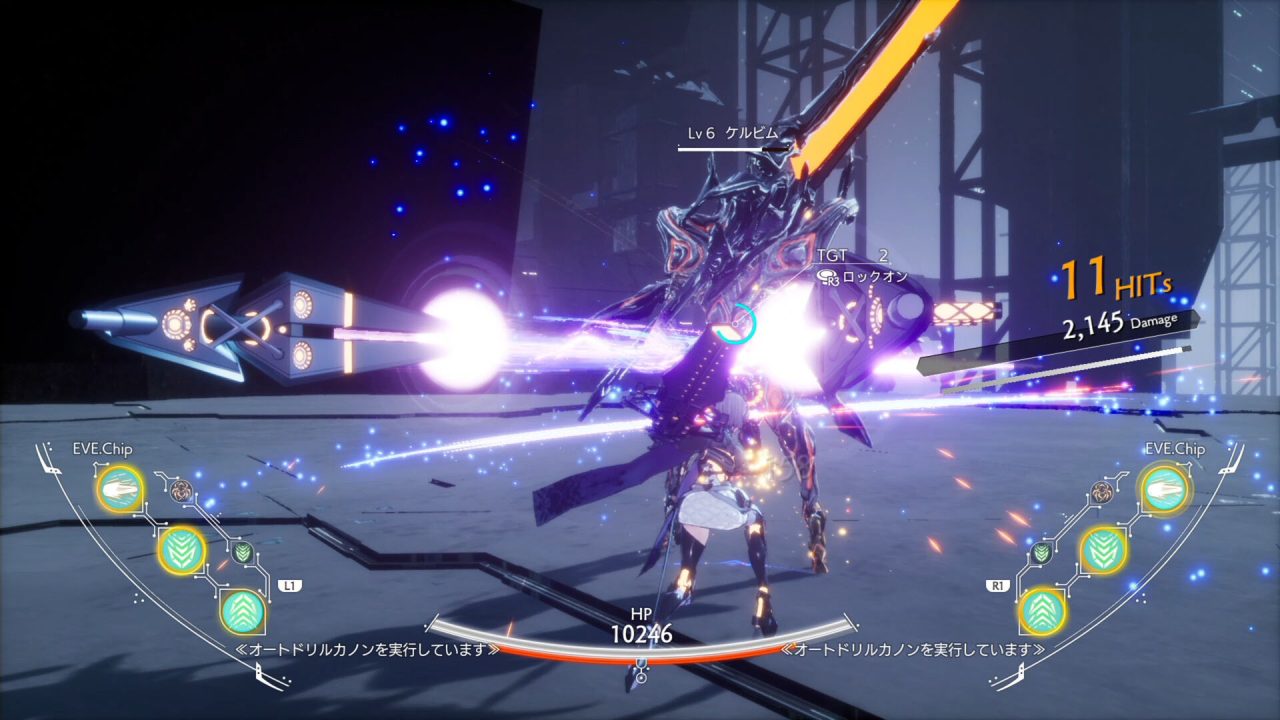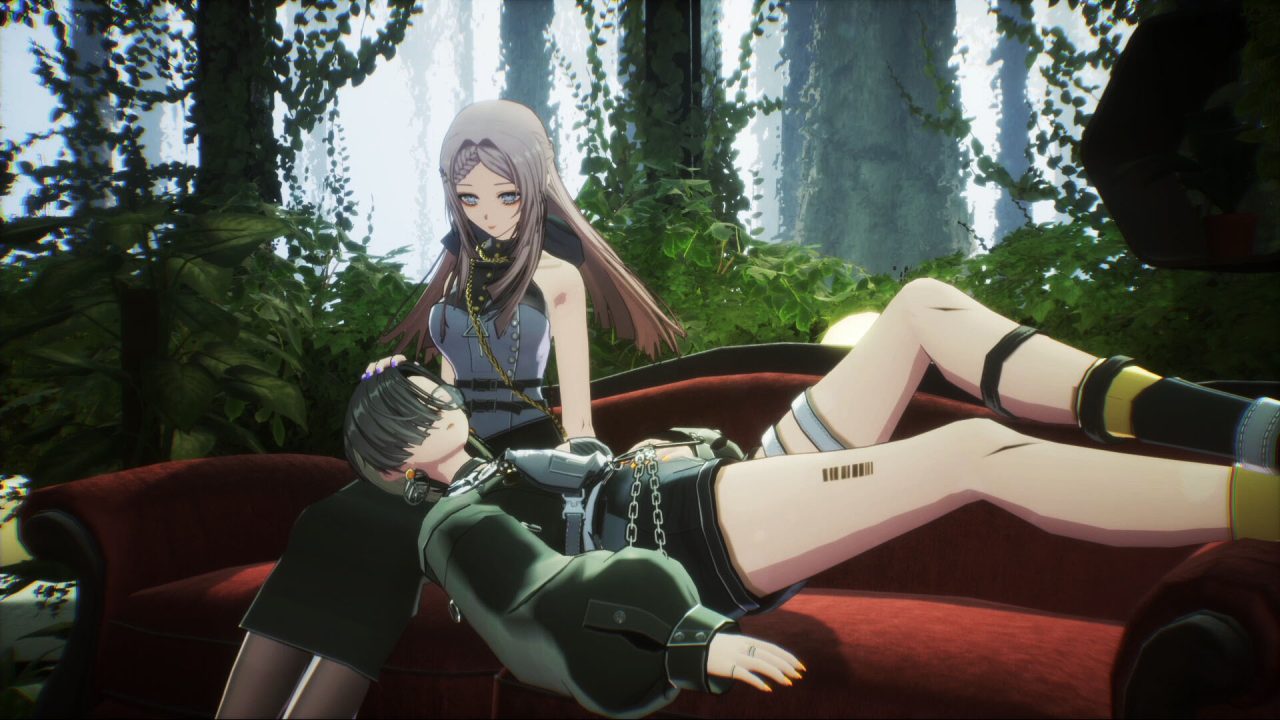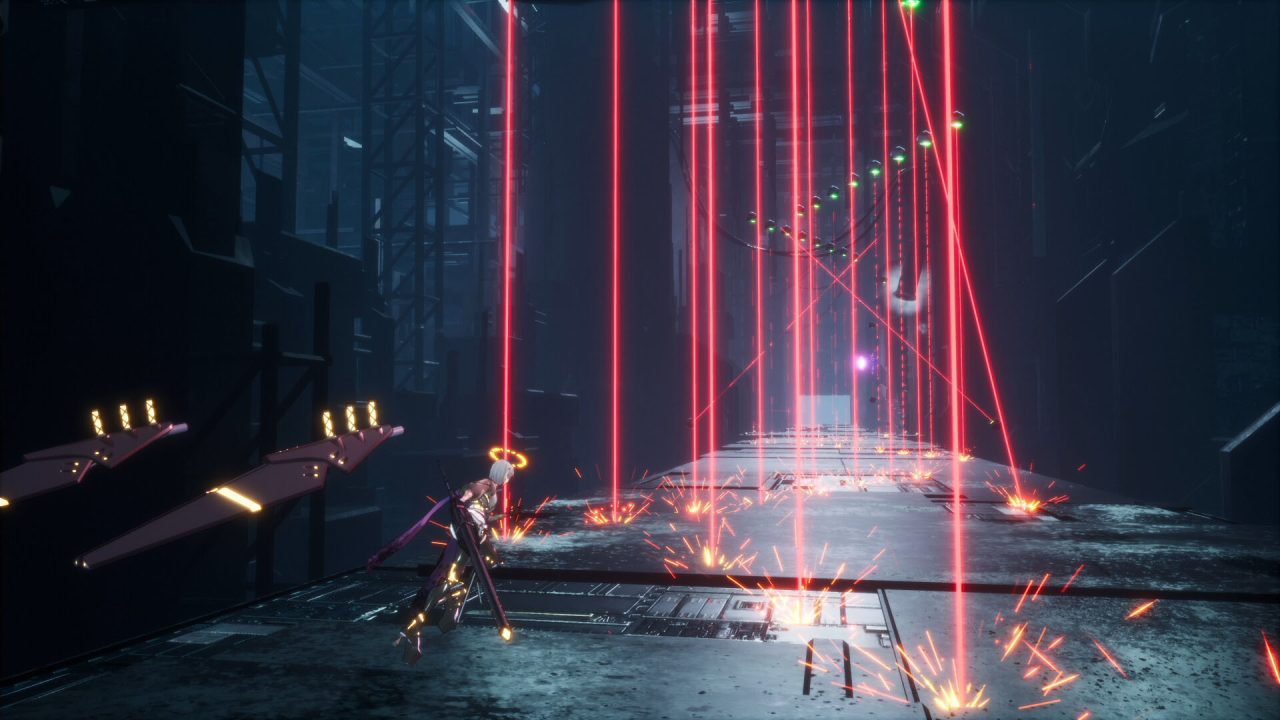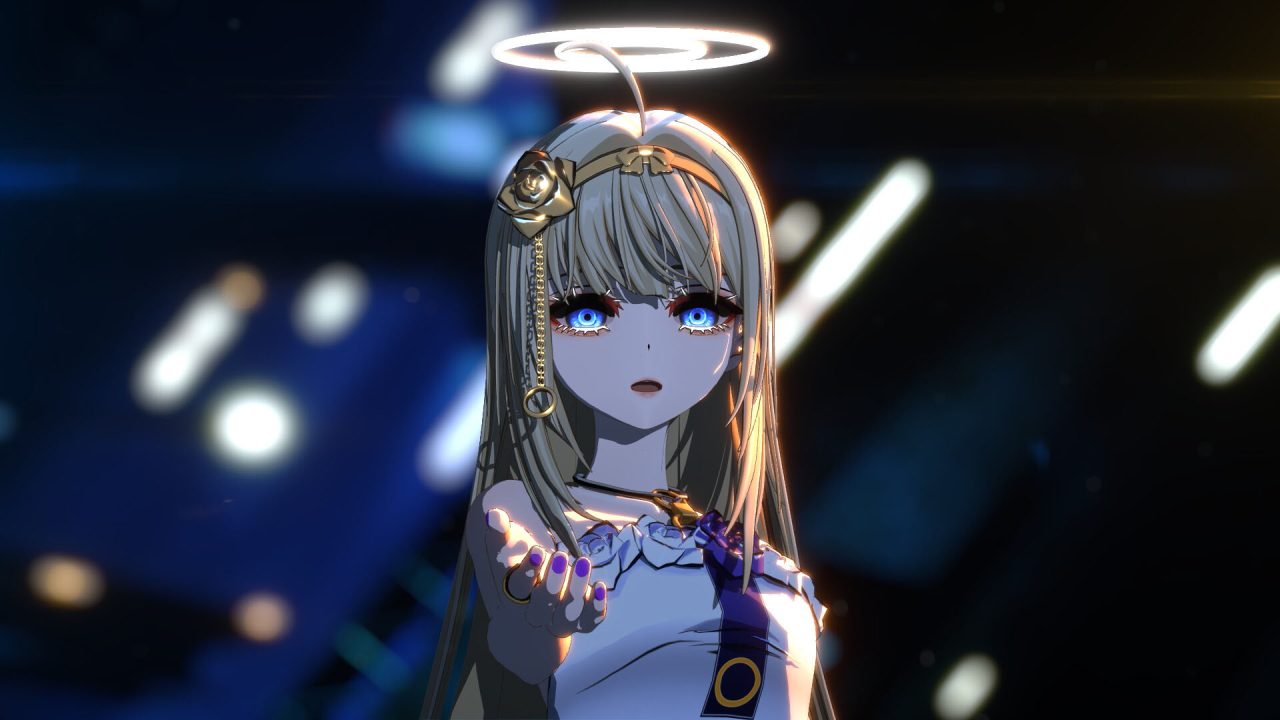Many consider artificial intelligence to be our future, but what happens once we’re all gone and AI is all that’s left? Crymachina seeks to answer this question in a follow-up to 2019’s Crystar. Crymachina shares many gameplay elements and philosophical themes from its predecessor while exploring a new setting. In Crystar, the story revolves around the concept of humans’ last thoughts lingering within purgatory. With Crymachina, humanity itself is already long gone, thanks to a rampaging sickness and a series of world wars that reduced it to little more than a memory. To save their future, humans launched spaceships, piloted by machines and AI whose sole purpose is to revive humanity. Crymachina follows the tale of a trio of revived humans and a machine god named Enoa who seeks to create true humanity once more.
Crymachina is, at heart, an action RPG. The general gameplay loop of Crymachina consists of taking on combat missions, building and customizing each character, and talking via Tea Parties to learn more about the world and gain more humanity. The out-of-combat portion is akin to a visual novel (or more accurately, a Japanese adventure game or ADV à la A.I.: The Somnium Files.) Tea Parties are brief conversations, often musing about a subject such as film theory or enemies’ motivations. Combat plays like a light character action RPG across relatively short missions. The gameplay loop feels small and bite-sized, almost as if the game was originally intended to be a mobile or portable project.
Although the gameplay elements are light, the story is oppressively heavy. The game opens with our heroine, Leben, lying in a hospital bed while she succumbs to a terminal illness known as Centrifugal Syndrome. As death anxiety finally tightens its grip around her during her last moments, the last thing she experiences is a mixture of hatred and despair. One day, she’s revived in a new mechanical body. She’s soon told that thousands of years have passed and humanity is long gone. Before the human race went extinct, there was a last-ditch effort to try to preserve their knowledge and find a way to revive humanity. This task falls to eight artificial intelligences—or Dei ex Machina—the last of which is Enoa, the main focus of Crymachina.

Crymachina touches on the concepts of ego and id, the weight of souls, the human condition, and myriad other philosophical talking points that caused many scholars sleepless nights and heated arguments. The game’s heroines face a new life in both digital and mechanical bodies, each left with fractions of their memory with one thing in common: memories of a sister. The primary heroine, Leben, is a moody loner who could be considered a grumpy misanthrope. Her distaste for humanity clashes with her sudden realization that she has the potential to become a real human once again and potentially serve as a key to reviving humanity. Her counterparts Mikoto and Ami serve as contrasts to her generally standoffish demeanor, with Mikoto acting as the cool and stylish film buff who has a quote for every situation and Ami serving as the group’s calm and collected motherly figure.
The writing in Crymachina displays emotional stories with dark and heavy subjects while mixing in sci-fi ideas. As all but three characters are machines, they seek to emulate humanity while acting as its guardians. Despite being machines made through perfect technology, they too are susceptible to madness. The depictions of fear and insanity on display as a machine tries to wrestle with the solution to the Drake Equation and The Fermi Paradox—all while in the middle of a boss battle—add a touch of humanity to the seemingly soulless robots. The writing can be very intriguing and engaging, yet since it arises during combat, it is easy to miss important and emotional lines.
When it comes to visuals, Crymachina‘s style is incredibly striking. The highly stylized portraits are dripping with personality and they translate over to 3D almost perfectly. Character designs straddle the line between cute, unsettling, and uncanny. As the game is about humans recreated as computer programs see them, it’s only natural that the transhumanism angle is on full display with metal limbs and frames that feel straight out of Xenoblade. While we view only small glimpses of the world design, it’s gorgeously brought to life (or lack thereof) and captures the essence of industrialized areas retrofitted to allow for human existence.
In comparison to its predecessor, Crystar, Crymachina is a massive leap when it comes to combat. The battle system is similar to Crystar: focused on light and heavy attacks with the occasional special ability thrown in. However, Crymachina makes drastic steps forward in expanding tools available to the player and customization options. Each character has a primary weapon, such as a spear, sword, or axe. While the primary weapon type cannot vary, there are many iterations of said weapons that can fit each player’s style of play. The same can be said for defensive gear sets, which have wildly varying stats and bonuses, such as higher HP at the cost of critical chance, more attack at the cost of defense, and faster recharges with less HP to fit a more blitzkrieg style of combat. There’s always a trade-off for those who seek to focus in one direction.
Shoulder weapons, or Auxiliaries, involve the most playstyle customization. Throughout the game, new Auxiliaries can be unlocked and swapped out. These may be swords, shields, spears, jammers, bots, chainsaws, and so on. Each one has a different style, yet you can slot them with basic and rare moves. Additionally, each weapon has a different EX conditional move that opens up a new combo path. These may include being close to an enemy, having the enemy airborne, the player’s gauge being below a certain threshold, perfect dodging an attack, and numerous other conditions. The option to add in rare yet consumable skills gives a bit of risk and reward to the system. I found myself with a move that perfectly fit my style, but as I only had one copy of it, I wanted to test every weapon type before committing. More often than not, I committed the moves and found the combination to be perfect for my needs.
Combat is a large part of Crymachina‘s gameplay loop. Most battles take place in small combat arenas and are usually composed of a few waves of robotic enemies. Initially, these encounters feel fairly basic and repetitive, yet they ramp up over time and introduce new enemies with new tools, including just-out-of-reach enemies. Luckily, players can swap into third-person shooter mode with L2 at any time and open fire on ranged foes whenever needed. Close combat often becomes chaotic, with enemies dashing in while the player counters and parries, breaks shields, and launches enemies before unleashing superattacks. Additionally, enemy attack indicators feel straight out of Final Fantasy XIV, ensuring some battles feel more like a dance through chaos rather than a straight brawl. Overall, battles feel like a lite version of NieR: Automata with a bit more jank.
Exploration in Crymachina is fairly limited, with battle maps consisting of relatively linear corridors with a few wider battle arenas mixed in. Thankfully, the level design becomes more varied later, leading to large vertical environments with puzzles and platforming or boss battles that require sliding along rails from place to place. Customization of character parameters allows players to adjust each of the three characters to their liking. For example, with Ami being a heavy hitter with a notable wind-up, I put more points into her stats that govern attack power while focusing more on critical hits for Leben and defense for Mikoto.
With Sakuyzo—one of Japan’s best electronic music creators—at the helm, Crymachina‘s soundtrack is simply superb in every way. The OST is rife with haunting and powerful melodies that have a mixture of ghostly vocals, traditional orchestral scoring, and the glitchcore aesthetic EDM fans are accustomed to. The overall audioscape feels like a mixture of Phantasy Star Online-style sci-fi melodies. Boss battles are where the music soars, as each boss has a dedicated theme song that plays throughout the encounter. Unfortunately, with how chaotic some fights can be, it may be difficult to catch the wondrous soundtrack while blades clash and lasers fly. The soundtrack can only be described as an aggressively melodic dreamscape, yet that makes it one of the best OSTs in recent memory.
Although Crymachina is a drastic improvement over Crystar, it still has some notable flaws. For starters, the story can seem needlessly convoluted with the heavy usage of terms like ExP (E cross P, which differs from EXP), E.V.E.s, EGO, Real Humans, and myriad other terms. The characters utilize a lot of acronyms, metaphors, and concepts, so it can get dizzying to keep track of them all. Fans of Crystar already know the developer’s usage of philosophical musings on the concept of humanity, and thankfully there is an in-game glossary that frequently gets updated as new information becomes available. Said glossary is also necessary to understand the slew of stats and what they affect, as the sheer number of them can be head-spinning.

Additionally, while combat is much improved, it’s still floaty and often feels janky. Despite being heavy robots with oversized weapons, there doesn’t feel like there is a notable weight behind attacks or dodges. There is also some notably stiff animation, especially during special attacks. Many animations are very robotic and doll-like, though as the characters inhabit robotic bodies, this becomes less of an issue as it begins to feel thematically appropriate. Finally, with how short the missions are and how piecemeal the game structure is, it can be hard to get momentum going, leading to some awkward pacing.
Much like its predecessor, Crymachina is extremely interesting in concept yet lacks a bit in execution. A strong aesthetic, incredible soundtrack, lovable characters, and a much-improved combat system make the experience enjoyable overall. Yet, the mission structure and general combat leave something to be desired. Thankfully, the game is short (just under 15 hours) and never overstays its welcome. Though its time is brief, Crymachina leaves a solid impression. Developer Aquaria is on the right track, and as a fan of both Crystar and Crymachina, I eagerly await the next entry in the Cry series.




